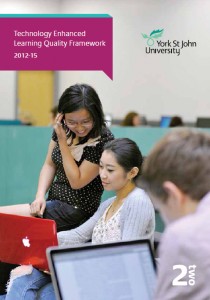
The aim of our TEL Quality Framework is to assist staff to meaningfully incorporate technology into learning, teaching & assessment, using the principles of the 3E Framework. Frameworks for technology enhanced learning (TEL) can adopt an approach driven by either the technology itself, or the pedagogical principles that underpin the learning that happens within the virtual environment. Each approach has merits and pitfalls. It is for this reason that we have adopted a combined approach that prompts staff to consider not only what tools they will use but how they will use them to facilitate student learning and what type of learning it is they wish their students to engage in.
3E Framework
Recognising the iterative nature of adopting technology, the 3E Framework is based on a tried and tested Enhance-Extend-Empower continuum for using technology to effectively support learning, teaching and assessment across disciplines and levels of study. The three broad stages within the continuum are:
Enhance: Adopting technology in simple and effective ways to actively support students and increase their activity and self-responsibility.
Extend: Further use of technology that facilitates key aspects of student’s individual and collaborative learning and assessment through increasing their choice and control.
Empower: Developed use of technology that requires higher order individual and collaborative learning that reflect how knowledge is created and used in professional environments.
Models & Frameworks
Combining traditional learning theories, such as constructivism, cognitivism & behaviourism, with contemporary theories such as connectivism, gives us the foundation on which to develop successful models for online & blended learning. Based on these theories, other models have been developed to underpin technology enhanced learning pedagogy, in this blog post we’ll take a look at just three of them: Mayes’ Conceptualisation Cycle, Laurillard’s Conversational Framework, and Salmon’s Five Stage Model.
Mayes’ Conceptualisation Cycle
“Conceptual learning is characterised as a cycle, involving the three stages which we term conceptualisation, construction and dialogue. These are mapped onto primary, secondary and tertiary courseware.”
(Mayes & Fowler, 1999)
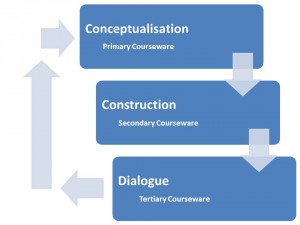
Conceptualisation (information dissemination): At the conceptualisation stage, students are exposed to other people’s ideas or concepts. The purpose of this stage is to provide the learner with an awareness of what they need to learn and understand, this is most commonly achieved in face to face classroom or lecture based sessions but also takes place in the VLE. Primary Courseware is used to support, for example, online lecture notes, instructional videos, reading lists etc, which are a good way of giving students information.
Construction (learning activity): At the construction stage tutors provide learners with meaningful online tasks that allow them to apply the concepts outlined to them in the conceptualisation stage, such as lab work, preparing presentations, writing blog posts, online quizzes, etc. The learning environment, tasks and task materials are referred to as Secondary Courseware.
Dialogue (dialogue & feedback): However, it is only at the dialogue stage, in the performance of tasks in which these new concepts are tested during conversation with tutors and peers, that learning takes place. This is achieved by students participating in effective computer based communication (CMC) with their tutors and fellow students whereby their understanding and conceptualisations outlined in stage 1 and applied in stage 2 can be assessed in applied contexts via online discourse which will bring to light any misconceptions about the subject and allow these to be addressed via meaningful online two way conversations. This is engagement with Tertiary Courseware e.g. discussion forums, videoconferencing, simulations etc.
Laurillard’s Conversational Framework
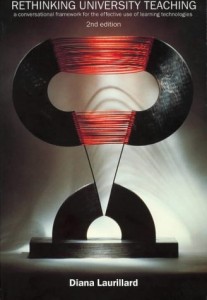
Laurillard’s Conversational Framework has been widely cited and used as both a design template and an analytic tool. Laurillard describes the stages involved in the dialogic interaction between a tutor and student, demonstrating the way in which concepts are internalised and adapted by each in the process. Laurillard stresses that, for higher level learning, dialogue must take place at both a theoretical and practical level.
This framework can be considered both learning theory and a practical framework for designing educational environments. Higher Education, according to Laurillard is much about acquiring “ways of seeing the world”. Associated pedagogic strategy has to consider different forms of communication and associated mental activities: Discussion, Adaptation, Interaction, Reflection.
Laurillard (1993, 2002) claims that there are four main aspects of the teaching-learning process and that different educational media can be analysed (and used) in terms of these dimensions:
- Tutors concepts
- Tutors constructed learning environment
- Student’s concepts
- Student’s specific actions (related to learning tasks)
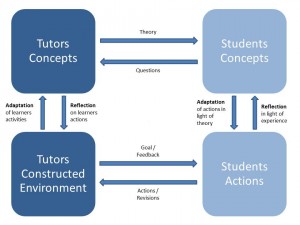
Each (larger) pedagogical scenario should include all four kinds of activities (communication forms) that happened in 8 kinds of ‘flows’ in the model:
1. Discussion (between the tutor and the learner)
- Tutors and learners’ conception should be mutually accessible
- Both should agree on learning objectives
2. Adaptation (of the learners actions and of the tutors constructed environment)
- Tutor must adapt objectives with regards to existing conceptions
- Learners must integrate feedback and link it to his own conceptions
3. Interaction (between the learner and the environment defined by the tutor)
- Tutor must ‘adapt to world’, i.e. create an environment adapted to the learning task given to the learner
- Tutor must focus on support for task and give appropriate feedback to the learner.
4. Reflection (of the learner’s performance by both tutor and learner)
- Tutor should support the learner to revise his conceptions and to adapt the task to learning needs
- Learners should reflect with all stages of the learning process (initial concepts, tasks, objectives, feedback, …)
Salmon’s Five Stage Model
“For online learning to be successful and happy, participants need to be supported through a structured developmental process.”
(Salmon, 2004)
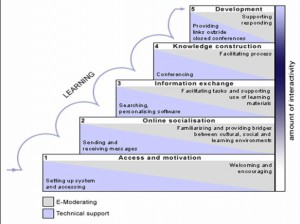
Professor Gilly Salmon first developed the practical Five Stage Model, ‘scaffolding’ a progressive learning environment through online activities, or ‘e-tivities’, as part of her own research into online learning and the use of computer-mediated communication (CMC), and published it in her book E-moderating. The five stages are:
- Access & Motivation. At stage one, e-moderators need to provide support and allow sufficient time to enable learners to access their course materials. Maintaining motivation in the early stages is important because you do not want to deter your learners before they have properly started the course. At this early stage, there will be little interaction between learners.
- Socialisation. Now that your learners have all successfully ‘arrived’, stage-two focuses upon encouraging your learners to get to know each other; even if you are teaching students online as part of a blended learning approach, and everyone has already met each other in the lecture theatre or seminar room, it is still important to go through this process in the online environment too.
- Information Exchange. On the successful completion of stage-two, your learners can be encouraged to share information as they continue to connect and build upon the relationships they started to develop with each other earlier. Exchanging information can be fun and beneficial but it can also be overwhelming if too much is shared and learners cannot identify what is useful to them.
- Knowledge Construction. At stage-four, learners should now be ready for more active online learning and can begin to construct new knowledge as a result of their interaction with one another, drawing upon each other’s skills and experience.
- Development. At stage-five, learners become more independent from the e-moderator and take more responsibility for their own learning and their group. Learner interaction with peers is not necessarily as frequent and demanding as seen in stages two to four, as learners can become more focused upon their individual learning goals again.
The amount of interactivity between an individual learner and their colleagues increases with each step. Importantly, as the expectations of participants increase, the role of the e-moderator shifts to a more facilitative role.
The 5-stage model is also at the core of Salmon’s E-tivity frameworks for enhancing active and participative online learning by individuals and groups. The term E-tivity means “task online”; it is a framework to learn something in a dynamic and interactive way. This activity is based on intense interaction and reflective dialogue between a number of participants, such as learners / students and tutors, who work in a computer-mediated environment.
Summary
As we look to review our TEL Quality Framework for 2015 and beyond, it is important to consider a range of models & frameworks, particularly those that are being used most extensively in a TEL context. As Conole (2010) suggests, models or frameworks, such as these, can be used as a type of schema to help mentally align to a particular pedagogical approach. Alternatively, they can be used directly to help guide the design of a learning activity or course, to help guide design decisions about what kinds of learning activities would be appropriate to promote the pedagogical approach instantiated in the model or framework. They can be used to guide the development of a learning environment, or they can be used as direct representations to the students, to help guide their learning process, or as analytic or descriptive tools to describe practice.
If you have any questions or comments then please leave them below, or you can contact TE@yorksj.ac.uk.
Phil
Further Reading
Laurillard, D. (2002). Rethinking University Teaching. A conversational framework for the effective use of learning technologies. London: Routledge.
Mayes, J.T. & Fowler, C.J.H. Learning technology and usability: a framework for understanding courseware. Interacting with Computers 11, 485-497, 1999.
Salmon, G. (2011). E-moderating: The key to teaching and learning online (3rd ed.). New York: Routledge.

0 responses on "ePedagogy Models & Frameworks"